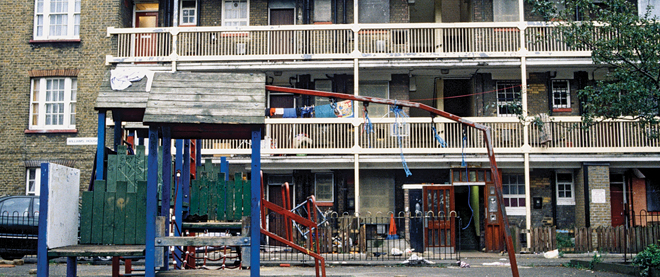London’s East End is transformed thanks to the Games
Too bad its poorest inhabitants have so far been shut out of competition
Getty Images
Share

There are few urban neighbourhoods in the world more darkly storied than London’s gritty East End. This is an area that has seen the absolute worst of the past several centuries, from the Great Plague to the Fire of London, from the horrors of the Blitz to Jack the Ripper and the notorious Kray twins, to last summer’s riots. But two weeks prior to the Olympics, all those terrifying memories seem a distant dream.
On a balmy Sunday evening in the borough of Hackney, in northeast London, the effects of gentrification are on dazzling display. What was a few years ago a down-market strip not far from London’s notorious “murder mile” is now a fashionable parade ground. Twenty- and thirtysomethings in Day-Glo skinny jeans and asymmetrical haircuts meet up for some cheap Vietnamese before grabbing a micro-ale at one of the many nearby bars, replete with carefully “distressed” interiors (think hand-chipped plaster and purposely paint-splattered tables). Just a few blocks away, urban gardeners and tourists in the know throng to the Columbia Road flower market where cockney costermongers still hawk their wares with traditional market cries of “Roses—six for a fiver!”
George Bernard Shaw’s Eliza Doolittle would be at home here, but today, so too would her aristocratic mentor, Henry Higgins. A few streets over in Shoreditch, there are trendy togs and overpriced lattes to be had and, for the lucky one per cent, a swim in the rooftop pool at Shoreditch House, London’s most lavishly furnished private social club.
It would seem logical to put this astonishing regeneration down to the Games, but in truth the forces of fashion were at work here long before the city won the bid in 2005. For the past couple of years, local artists have been declaring the district officially “over”—a sure sign that for the general public, it’s just begun. As the warehouse rents go up and artists move out (many to cheaper studios in the city’s southeast), the aspirational middle classes are moving in.
One of London 2012’s much-trumpeted “legacy promises” was to “transform the heart” of this area, and on first glance it seems to have worked. The two-year-old east London Overground extension links the district from north to south to west. In Stratford, where the Olympic village is located, toxic land has been cleaned up to make room for condo developments and a gleaming new shopping mall.
But look closer and the real story is much more complicated—and in some ways disheartening. The first part of a comprehensive report, the “Olympic Games Impact Study: London 2012,” released two years ago, found that while the Games have been very good for certain aspects of the city—the competitiveness of top athletes, political involvement, crime reduction—the impact on London’s crime-ridden east has been almost negative. The areas of health and welfare, nutrition, community and school sports facilities, affordable housing, and volunteerism all scored an “indeterminate impact”—meaning they’ve seen little or no improvement—just two years before the Games. While the final report won’t be out until 2015, if current trends continue, the at-risk populations of east London’s “host boroughs” (some of the city’s poorest, including Greenwich and Tower Hamlets) may well be no better off than when they started, despite the proliferation of trendy condo developments, coffee bars and gastro pubs.
In this sense, the east has been transformed on both ends of the socio-economic scale. While property values have gone up in trendy Hackney and around the Olympic site, so have the numbers of poorer inner-city residents leaving London for the outer east.
Seen on a large scale, such an evolution may be a good thing. According to Alex Fenton of the London School of Economics’ Centre for Analysis of Social Exclusion, the change “provides the springboard for the broader aim of moving London’s heart eastward.”
The secondary “legacy” phase of the Olympics plan will not be complete for some years to come, and many observers are confident there will be significant benefits to the local population once all is said and done. For instance, a third of the athlete’s village will be turned into affordable housing once the Games are finished, and there will be plenty of public green space where once there was an industrial wasteland. At the very least, London 2012—which has so far come in on time—looks on course to deliver an Olympic legacy of “no white elephants,” as Paul Deighton, chief executive of the London Olympic Organising Committee, promised the city’s business leaders in a speech earlier this year.
On the cusp of the Games, London’s trendy east is certainly trained up and ready for its star turn on the podium. In the fashionable-neighbourhood finals, it’s already won a gold. Too bad its poorest inhabitants have so far been shut out of competition.